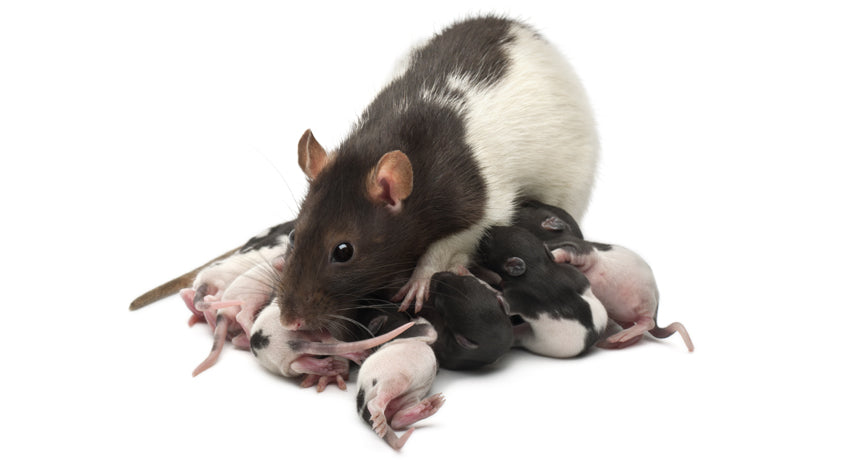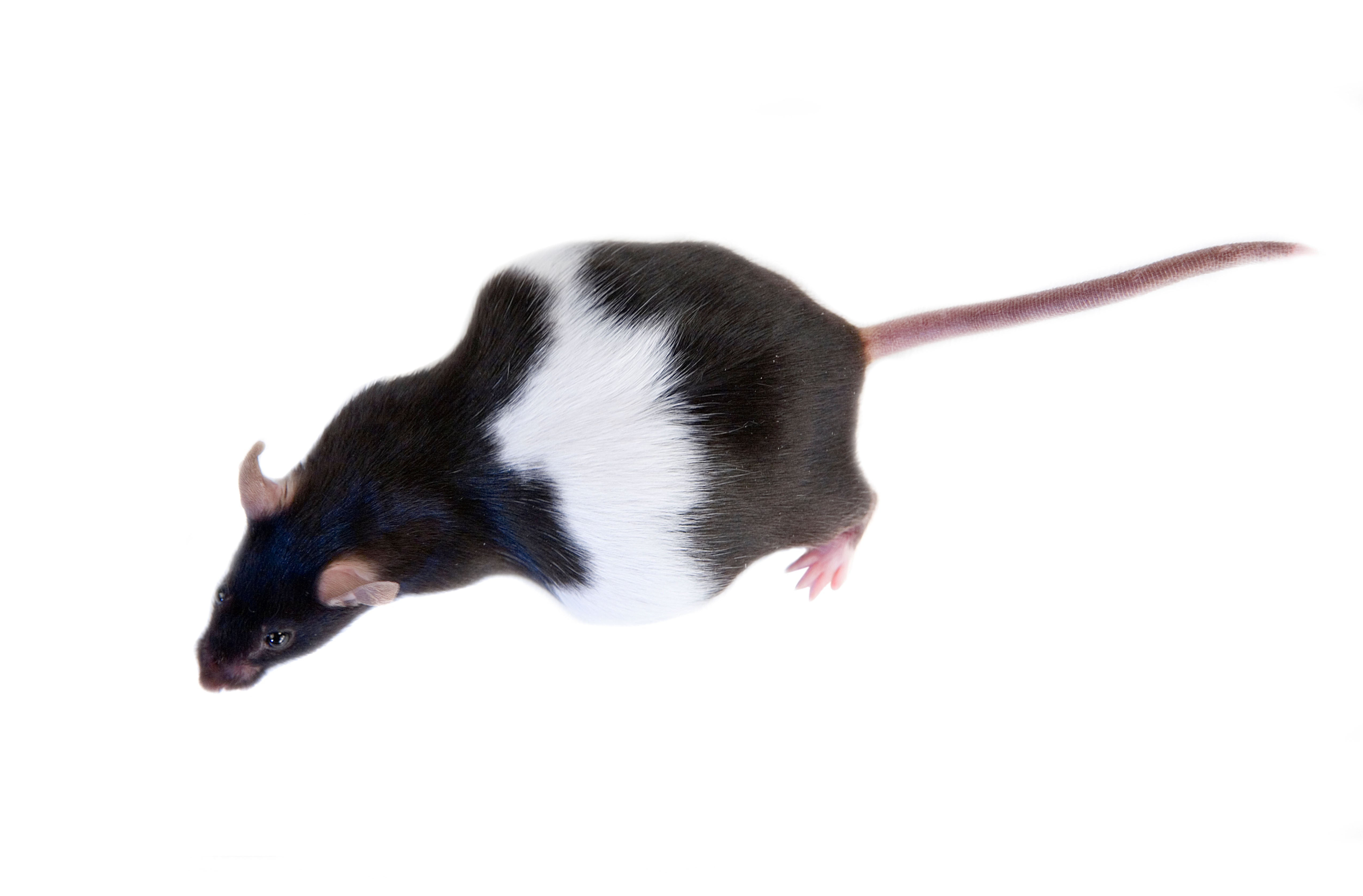From Mating to Delivery
Understanding the Estrus Cycle
In rodents, the reproductive cycle, called the estrous cycle, lasts approximately 4-5 days and includes 4 phases (1, 2):
- Proestrus: pre-ovulation period characterized by a decline in progesterone and the development of both the endometrium and ovarian follicles, that last 12-24 hours.
- Estrus: ovulation stage where a female is in heat i.e. receptive to a male and to mating. This stage lasts about 12-48 hours.
- Metestrus: quiescent period if fertilization and implantation do not occur, when the activities of reproductive organs gradually subside.
- Diestrus: short period of rest in between cycles, lasting ~48-72 hours. Rats and mice are polyestrus, meaning that they get multiple estrus cycles throughout the year. You can also hear the term "anestrus": this stage is not part of the estrous cycle, but a prolonged period of sexual rest where the reproductive system is quiescent.
Supporting Healthy Pregnancy
When fertilization occurs, the average gestation time is 19-21 days for mice and 21-23 for rats. Once the female is fertilized, different option are available for the male (3):
- If you aim for timed pregnancies or for pups of the same age, the male can be removed just after the vaginal plug is seen (see our blog our timed pregnancies).
- With continuous matings, the male is left with the females at all time. Postpartum estrus occurs within 24 hours of parturition, and the female is likely to
become pregnant again while lactating and nursing the new litter, maximizing productivity. - If you opt for non-continuous breeding, the male can be removed just before birth, maximizing the female's available energy for lactation and pup rearing) or just after the litter is born, utilizing the postpartum estrus, while providing more space for pup rearing.
Nutritional needs are high during gestation: Omega3s (especially DHA) are essential to ensure optimal fetal brain, eye, immune and nervous system development; folate (Vitamin B9) is needed for the closure of the neural tube; and iron in response to the increased blood volume to assist the growth of the fetus, the placenta and the maternal tissues (see our blog on rodent gestation needs). Make sure to provide your breeders with appropriate nutrition!

REQUEST YOUR FREE SAMPLES NOW!
Assisting Parturition
Mice and rats usually deliver during the night, with each pup being delivered ~15-30 minutes apart (4). Pups are discovered by the animal caretaker during the first morning check, and some issues can be seen at that point. Pelvic organ prolapse (protruded vagina or uterus) (5) and dystocia (defined as difficult or obstructed labor) (6), are issues associated with parturition (see prevention and treatments in our blog on dystocia).
After pups are born, the cage is left undisturbed for at least three days except for replenishing of food and water. If a cage change is needed, transfer the female to a new cage, then gently scoop the whole littler with bedding and nesting material to the new cage to transfer scent and avoid rejection or cannibalism of the litter by the female (see our 2 previous blogs on cannibalism: How to Reduce Cannibalism in Your Rodent Colonies & Cannibalism in Laboratory Rodents: Stressors to Avoid)
Pup Rearing
Supporting the High Demands of Lactation
Litter size varies depending on the strain or genetic background of the animals, but on average, mice will give 6-8 pups per litter, while rats may go up to 6-12 babies per litter. Female mice have 5 pairs of mammary glands and nipples (3 pectoral and 2 inguinal) while rats have 6 pairs (3 of each). Mice and rats babies are born with no fur, they are bright pink (hence why they are sometimes called "pinkies"). Their eyes and ear canals are sealed, and a white spot (stomach full of milk) is visible on their left side if lactation is going well (7). At day 2-3, their ears start to come away from the head; at day 7 their fur starts to appear, and at day 14, their eyes open. After that, they start eating solid food and increase in weight and size.
During lactation, the mouse achieves a third of its growth, imposing a high nutritional burden on the female: healthy fats for brain and eye development, high protein for growth, calcium and vitamin D for strong bones (see our bog on lactation). Support your females by providing them with a high protein supplement such as DietGel® Prenatal.
Weaning Rodent Pups
For both mice and rats, pups are usually weaned at 21 days of age. In specific circumstances, some pups might benefit from an extra week with the mom, and later weaning at 28 days of age. Those include small, weak, runt pups from specific strains such as certain inbred or genetically modified strains. In any case, limit the cage to a single generation, and wean the older litter before the new litter is born (8). This helps prevent overcrowding of the cage, which can be a significant welfare issue as small animals run the risk to be trampled and killed.
Weanlings should be separated by sex, and males from different litters should not be combined to avoid fighting (especially in mice). Females can be combined more easily. In their new cage, weanlings can sometimes have a hard time in the first few days to find the water source and food source, and mortality is sometimes observed after weaning. To prevent that, simply provide a reachable source of water and food.

REQUEST YOUR FREE SAMPLES NOW!
Helping the Females Recovery
In two studies, done in collaboration with Indiana University (9) and Maine Medical Center Research Institute (10), breeding females were found to have significantly higher body weights during and after lactation, suggesting quicker recovery after birth. Anecdotal evidence suggests that females given DietGel® Prenatal are quicker to rebreed, and show a decreased time in between litters. A study is currently ongoing to assess those measurements.
To learn more, check out our Breeding Support blog series
References:
(1) Estrous Cycle
(2) Staging of the estrous cycle and induction of estrus in experimental rodents: an update
(3) Rat Breeding and Housing Density, Indiana University
(4) Common Rodent Treatments - McGill University
(5) Pelvic organ prolapse in fibulin-5 knockout mice: pregnancy-induced changes in elastic fiber homeostasis in mouse vagina
(6) Health Evaluation of Experimental Laboratory Mice
(7) JAX® Mice Pup Appearance by Age
(8) Guidelines for Management and Maintenance of Rodent Breeding Colonies - University of British Columbia
(9) Evaluation of Six Industry Diets on the Reproductive Success of DBA-2 Mice - Indiana University
(10) DietGel® Prenatal Improves C57BL/6J Breeding Performance and Pup Health - Maine Maine Center Research Institute




Leave a comment
All comments are moderated before being published.
This site is protected by hCaptcha and the hCaptcha Privacy Policy and Terms of Service apply.